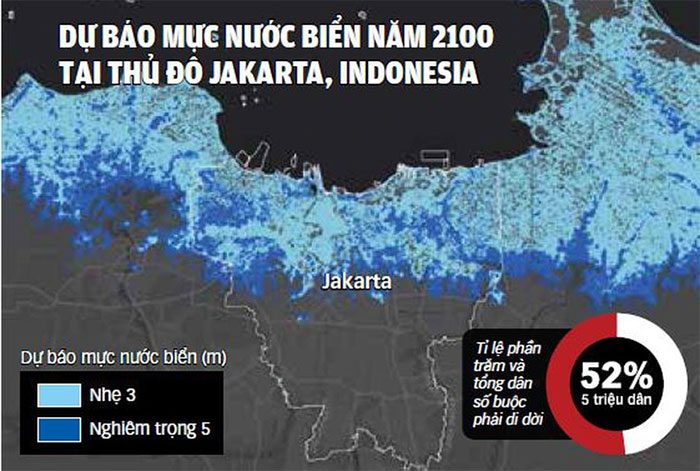The capital city of Jakarta is sinking rapidly and is currently the fastest sinking megacity in the world, at a rate of 25cm per year. Indonesia is implementing a mega project for a sea wall to save the city.
Experts predict that approximately one-third of Jakarta, located on the island of Java, will be submerged by 2050 if authorities do not implement effective solutions, while flooding continues to worsen, according to Bloomberg News.
Costing Tens of Billions of USD

Illustration of the sea wall project for the megacity of Jakarta, Indonesia – (Photo: NCICD).
On January 10, in Jakarta, Indonesia’s Coordinating Minister for Economic Affairs Airlangga Hartarto announced the latest plan for the sea wall mega project in Jakarta. The project will consist of three construction phases extending until 2040, with the first two phases requiring 164.1 trillion rupiah (approximately 10.5 billion USD). Mr. Hartarto did not mention the estimated budget for the third phase.
Meanwhile, Indonesia’s Minister of Defense Prabowo Subianto stated that 50 to 60 billion USD is the necessary amount for the project to address Java’s concerns.
“The Netherlands has done something similar and it took them 40 years. The challenge is to have political leaders who can look ahead and utilize all resources over a period of 40 to 50 years,” said Subianto.
The idea of constructing a sea wall has existed for over a decade but has only recently been revived as Jakarta has become the fastest sinking city in the world due to excessive groundwater extraction and urban development, while the tidal flooding has increased to 200cm per year.
If completed, the project will include the construction of a 120km long dam along the river and coastline by 2030, a sea wall on the eastern and western sides of Jakarta by 2040, and a reservoir at the end of the wall by 2050.
Jakarta aims to complete the first phase of the coastal dike construction program under the National Capital Integrated Coastal Development (NCICD) project by 2027. So far, 13 out of 46km of the planned sea dike have been completed.
The sea wall project also aims to address water supply issues in Jakarta, which has been heavily reliant on groundwater extraction. This wall will include a reservoir to store rainwater, river water, and provide clean water for the city.
Mr. Hartarto estimates that flooding in coastal Jakarta causes damages of 2.1 trillion rupiah per year (135 million USD) and could potentially rise to 10 trillion rupiah per year (642.7 million USD) in the next decade.

Data as of January 20, 2023. (Source: Earth.org – Data: Anh Thu – Graphics: TUẤN ANH).
Still Many Concerns
Opponents argue that the sea wall mega project will only exacerbate the ecological and social crisis in the region, calling on the government to adopt a more environmentally friendly approach.
To slow the sinking rate and reduce pressure on Jakarta, Indonesia has restricted groundwater extraction and is accelerating the construction of the new capital, Nusantara, valued at 34 billion USD on the island of Borneo.
However, at the event on January 10, some experts also proposed more environmentally friendly alternatives to reduce rising sea levels, according to Benar News.
The idea of building a sea wall for Jakarta was first proposed in 2010 but faced opposition from some environmental groups and local politicians who argued that the project would affect the livelihoods of many and harm marine ecosystems.
The coalition of environmental and social groups called Maleh Dadi Segoro believes that instead of solving the problems of subsidence and coastal flooding, the project could shrink fishing grounds, threatening the livelihoods of many who depend on the sea.
Meanwhile, city planning observer Nirwono Joga from Trisakti University stated that the main cause of subsidence in northern coastal Java is uncontrolled groundwater extraction due to limited clean water supply and high demand from buildings and industries. Heavy trucks also add pressure to the alluvial land in the northern coastal region of the island.
“Why not choose or combine with a more environmentally friendly approach, such as restoring Jakarta’s coastal areas and planting mangroves as a natural barrier to reduce rising tides and tsunamis – methods that are cheaper and easier?” Mr. Nirwono suggested.


















































